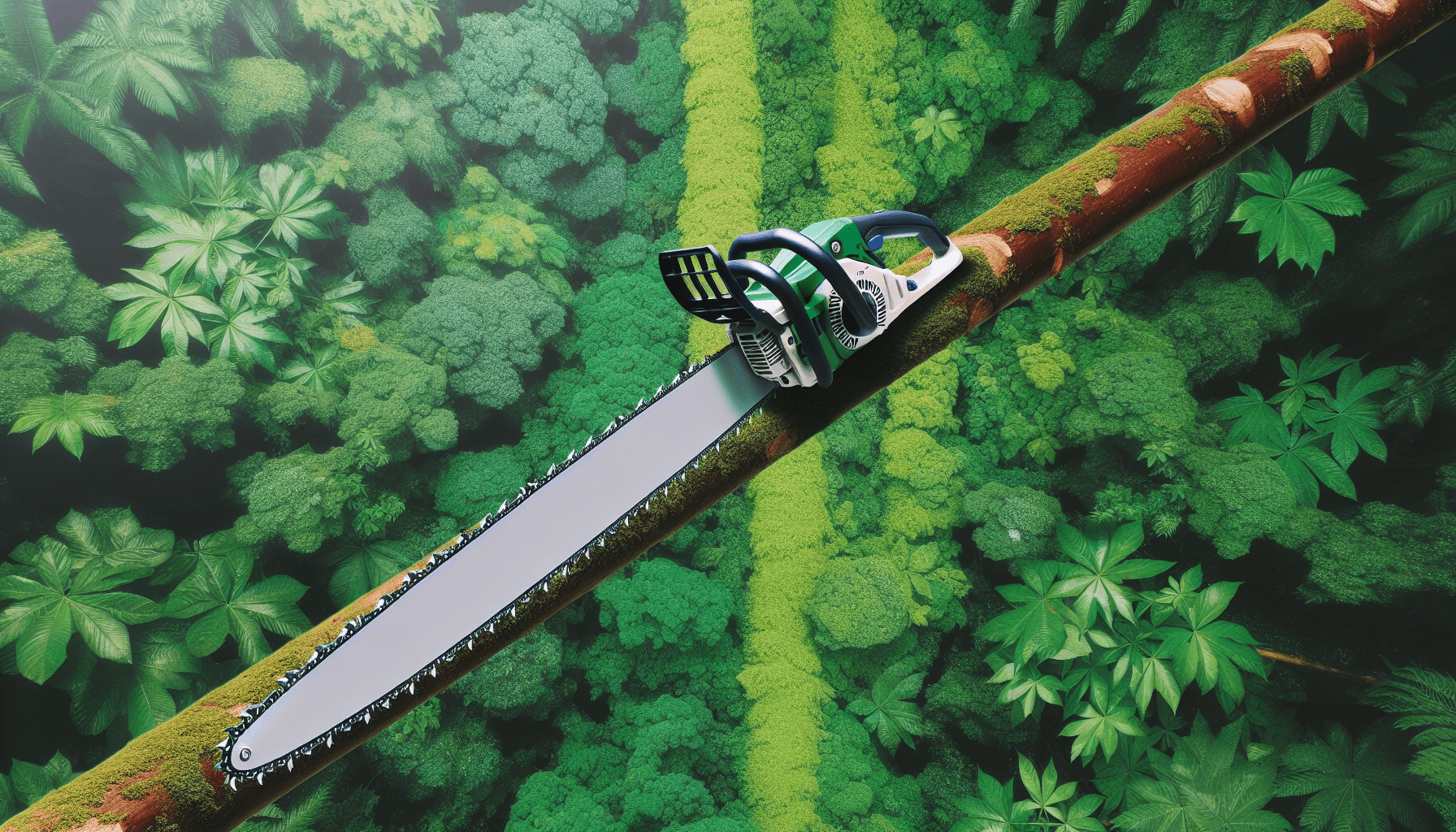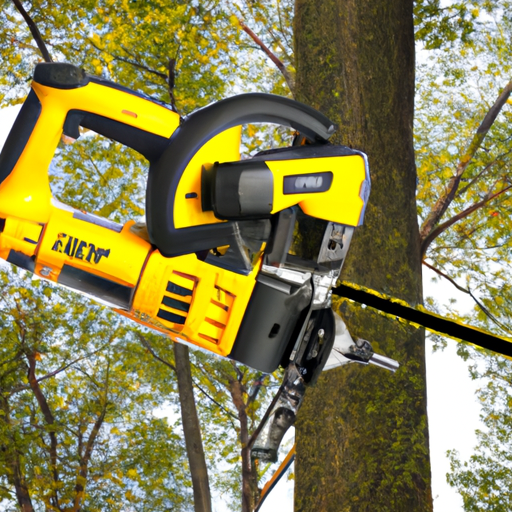So you’re wondering if you can use a pole saw instead of a chainsaw? Well, let’s clear that up for you. While they may look similar, there are a few key differences between the two tools. A chainsaw is typically more powerful and versatile, allowing you to tackle larger, thicker branches and logs with ease. On the other hand, a pole saw is designed specifically for pruning and trimming branches that are out of reach. So, if you’re looking to trim those high branches, a pole saw is the way to go. However, if you have heavy-duty cutting tasks in mind, you’ll definitely need a chainsaw.
Differences between Pole Saw and Chainsaw
Physical Design
The physical design is one of the key differences between a pole saw and a chainsaw. A pole saw consists of a long pole with a saw blade on the end. It is specifically designed to reach high branches and trim them safely from the ground. On the other hand, a chainsaw is a handheld power tool with a motor and a chain with sharp teeth. It is designed for more heavy-duty cutting tasks and offers greater maneuverability.
Reach and Mobility
When it comes to reach and mobility, the pole saw takes the lead. With its long pole, it enables you to access branches that are high up in trees without the need for a ladder or climbing equipment. This is especially useful for those who want to avoid the risks associated with climbing ladders and working at heights. Chainsaws, on the other hand, offer greater maneuverability and are more suitable for working on the ground or in tight spaces.
Power Source
Another major difference between the two is the power source. Pole saws are typically powered by electricity or a rechargeable battery, offering a more eco-friendly option. Chainsaws, on the other hand, are commonly powered by gasoline engines, providing a more powerful cutting experience. The power source you choose depends on your specific needs and preferences.
Cutting Capacity
In terms of cutting capacity, chainsaws are more powerful and efficient compared to pole saws. Chainsaws are designed to handle larger jobs, such as felling trees or cutting firewood. They have a greater cutting capacity and can tackle thicker branches and trunks with ease. Pole saws, on the other hand, are ideal for smaller pruning and trimming tasks, as they are not as powerful as chainsaws.
Advantages of Using a Pole Saw
Safety
One of the main advantages of using a pole saw is the increased safety it provides. With a pole saw, you can safely trim branches from the ground without the need to climb ladders or work at heights. This significantly reduces the risk of falls and injuries associated with using a chainsaw on a ladder.
Reach and Accessibility
A pole saw allows you to easily reach and access branches that are high up in trees. This is particularly useful when dealing with overhead branches or limbs that are difficult to reach with a chainsaw. The extended reach of a pole saw eliminates the need for precarious climbing or using a cherry picker truck.
Pruning and Trimming
Pruning and trimming small trees, as well as maintaining shrubs and hedges, are made easier with a pole saw. The long pole allows you to reach and trim even the highest branches without strain. This makes it the perfect tool for maintaining a well-manicured garden or landscape.
Lightweight and Easy to Handle
Pole saws are generally lightweight and easy to handle. They are designed to be user-friendly, enabling even less experienced individuals to use them comfortably. The lightweight nature of the pole saw reduces fatigue during extended periods of use, making it a popular choice for homeowners and garden enthusiasts.
Advantages of Using a Chainsaw
Cutting Power and Efficiency
When it comes to cutting power and efficiency, chainsaws are unmatched. They have the ability to cut through thick branches and tree trunks with ease, thanks to their high-powered engines and sharp chains. If you have a lot of heavy-duty cutting to do, a chainsaw is the better choice.
Versatility
Chainsaws are incredibly versatile tools. They can be used for a wide range of tasks, from cutting firewood to felling trees. With the right chain and bar, a chainsaw can handle various types and sizes of wood, providing the flexibility needed for different applications.
Suitable for Larger Jobs
If you have larger jobs like felling or cutting down trees, a chainsaw is the ideal tool. Its power and cutting capacity allow for more efficient and effective work, saving you time and effort. It is the go-to tool for professional loggers and arborists.
Ease of Use
Despite their power, chainsaws have become increasingly user-friendly. Modern chainsaws feature advanced safety features and ergonomic designs that make them easier to handle and operate. While some learning and practice are still required, chainsaws are now more accessible to a wider range of users.
Suitable Applications for Pole Saw
Pruning and Trimming Small Trees
Pole saws excel in pruning and trimming small trees. Their long reach allows you to maneuver around the branches and remove dead or overgrown limbs with ease. They are perfect for maintaining the health and appearance of your backyard trees.
Overhead Branches and Limbs
If you have overhead branches or limbs that pose a safety hazard or obstruct the view, a pole saw is the perfect tool to reach and trim them. You can safely stand on the ground and extend the pole saw to reach those branches that are out of reach with a chainsaw.
Tall Shrubs and Hedges
Keeping tall shrubs and hedges in shape can be challenging without the right tools. A pole saw provides the necessary reach to trim the tops of tall shrubs and hedges without the need for a ladder or heavy machinery. It allows for precise and controlled pruning, ensuring your landscaping looks its best.
Suitable Applications for Chainsaw
Felling Trees
Felling trees is a job best suited for a chainsaw. With its powerful cutting capacity, a chainsaw can tackle large tree trunks and bring them down safely and efficiently. However, felling trees requires proper training and caution to ensure safety.
Cutting Firewood
When it’s time to stock up on firewood for the winter, a chainsaw is an essential tool. Its cutting power allows you to quickly and easily cut logs to the desired length. Chainsaws can handle both hardwood and softwood, making them versatile for all your firewood needs.
Tree Limbs and Large Branches
If you have tree limbs or large branches that need to be removed, a chainsaw is the tool for the job. Its cutting power makes it easy to tackle even the thickest branches with precision. Chainsaws are commonly used by arborists to prune and trim trees professionally.
Safety Precautions when Using a Pole Saw
Wear Safety Gear
When operating a pole saw, it is crucial to wear proper safety gear. This includes a hard hat, safety glasses or goggles, hearing protection, sturdy work gloves, and boots with good traction. Safety gear helps protect you from falling debris and potential accidents.
Inspect Equipment Before Use
Before using a pole saw, always inspect it for any damage or loose parts. Check the blade for sharpness and ensure that the pole is securely attached. Faulty or damaged equipment should not be used, as it can lead to accidents or injuries.
Stay Clear of Power Lines
When using a pole saw, it is essential to be aware of nearby power lines. Always maintain a safe distance from power lines to avoid potential electrocution or accidents. If you need to work near power lines, consider contacting professionals for assistance.
Secure and Stable Footing
Ensure that you have a secure and stable footing before using a pole saw. Look for a flat and level surface and be mindful of any obstacles that may affect your balance. Uneven or slippery terrain should be avoided to prevent falls and accidents.
Safety Precautions when Using a Chainsaw
Proper Training and Handling
To safely use a chainsaw, proper training and handling techniques are essential. Attend a chainsaw safety course or seek guidance from experienced professionals to familiarize yourself with the correct operating procedures. Always read the manufacturer’s instructions and follow recommended safety protocols.
Wearing Protective Clothing
When operating a chainsaw, wearing the appropriate protective clothing is crucial. This includes a helmet with a face shield or goggles, hearing protection, work gloves, chaps or chainsaw pants, and boots with good traction. These protective measures reduce the risk of injuries from flying debris or accidental contact with the chainsaw.
Maintaining a Safe Working Area
Clear the work area of any obstacles or debris before using a chainsaw. Ensure that there are no bystanders or pets in the vicinity. Keep a safe distance from other people, structures, or vehicles to prevent accidents. Maintaining a safe working area is essential for the safe operation of a chainsaw.
Avoiding Kickbacks
Kickbacks are one of the most common causes of chainsaw accidents. To avoid kickbacks, always hold the chainsaw with both hands and maintain a firm grip. Position yourself to the side of the saw, away from the cutting path. Regularly inspect the chainsaw’s chain and bar for any signs of wear or damage that can contribute to kickbacks.
Cost Considerations
Price Range of Pole Saws
Pole saws come in a wide range of prices, from as low as $50 to over $300. The price is influenced by factors such as the length and material of the pole, the cutting capacity, and the power source. Entry-level models are typically more affordable, while professional-grade pole saws tend to be higher in price.
Price Range of Chainsaws
Chainsaws vary in price depending on their size, power, and features. Entry-level chainsaws can cost around $100, while high-performance professional chainsaws can exceed $1,000. The price also depends on whether it is a gasoline-powered chainsaw or an electric chainsaw.
Additional Equipment and Maintenance Costs
In addition to the initial purchase, there are additional costs to consider. Both pole saws and chainsaws require maintenance, such as blade or chain sharpening and regular oiling. Additional equipment like safety gear and spare parts should also be factored into the overall cost.
Summary and Conclusion
In conclusion, both pole saws and chainsaws have their advantages and suitable applications. Pole saws excel in reaching high branches and are particularly useful for pruning and trimming small trees, overhead branches, and tall shrubs and hedges. They are lightweight, easy to handle, and offer enhanced safety compared to chainsaws.
Chainsaws, on the other hand, offer superior cutting power and efficiency. They are versatile tools suitable for larger jobs like felling trees, cutting firewood, and removing tree limbs and large branches. While chainsaws require proper training and handling, they provide greater maneuverability and cutting capacity.
When choosing between a pole saw and a chainsaw, consider the specific tasks at hand, your comfort level, and the level of power required. Always prioritize safety by wearing appropriate protective gear, inspecting equipment before use, and being cautious of power lines and potential hazards.
Ultimately, the choice between a pole saw and a chainsaw depends on your personal needs, preferences, and the nature of the work you intend to undertake. Make an informed decision based on the information provided, and ensure that you follow proper safety protocols for a successful and safe cutting experience.
References
- Lowe’s. “Pole Saws Buying Guide.” Lowe’s Home Improvement. Link
- The Home Depot. “Chainsaw Buying Guide.” The Home Depot. Link
- Husqvarna. “Chainsaw Safety Tips and Tricks.” Husqvarna.com. Link
- STIHL. “Pole Pruners & Power Pole Saws Guide.” STIHL USA. Link
Note: This article is for informational purposes only and should not be considered as professional advice. Always consult manufacturer guidelines and seek professional guidance when operating power tools.



